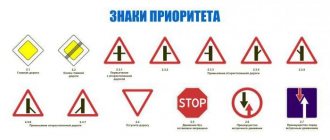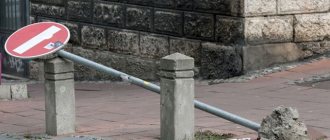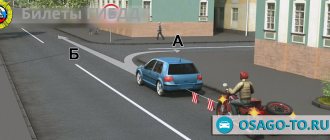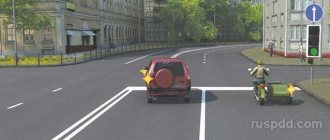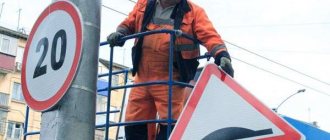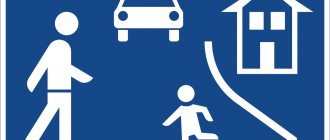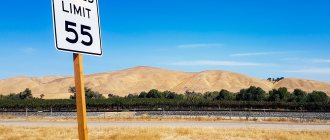Sign 3.13 “Height limitation”
Road sign 3.13 “Height limit” is used to prohibit the movement of vehicles whose overall height (laden or unladen) is greater than that indicated on the sign.
The sign is installed in cases where the distance from the road surface to the bottom of the span of an artificial structure, utilities, gates, etc. (span height) less than 5 meters.
The height indicated on the sign is 0.2 - 0.4 meters less than the actual height. These are the norms. Moreover, this difference between the actual height and the height indicated on the sign can be increased depending on the evenness of the road surface (the number on the sign is slightly less than the actual span height).
If the height of the vehicle (with or without a load) is greater than indicated on the sign, then the driver must drive around the road section along a different route. To warn the driver about the vehicle height restriction ahead, sign 3.13 is duplicated, i.e. are also pre-installed.
Preliminary sign 3.13 “Height limit” with plate 8.1.1 “Distance to object” is installed behind the intersection at the beginning of the road section on which vehicle height restrictions are introduced. Accordingly, at this intersection it is possible to choose a different route.
Repeated sign 3.13 (main) is installed directly at the place of restriction. It is allowed to install a sign on the span of an artificial structure, and if there is a large gate in front of it, on the gate.
The yellow background of sign 3.13 “Height limitation” means that the sign is temporary.
Requirements
The height restriction sign is prohibitive. There are separate provisions regarding it in the legislation. In particular, the legislator reflects the rules according to which the specified sign is installed. This is done to ensure safety for the residents of the country.
Places for such installation are:
- sections of the route where gas pipelines are located;
- location of the overpass;
- bridges.
This also includes other structures that allow cars to pass under them. Height restriction signs are also placed in areas where tunnels are located. Any route must be built taking into account what is shown on the map. According to the rules, the use of these structures is permitted in the case when the car has a lower height than that provided for by the building.
Travel on the metro is not affected by these provisions. The gate in some situations also has an indication of the sign in question. Carrying cargo by transport is also required in accordance with established regulations. The height sign indicates the maximum size that a car can have. Car drivers must take these provisions into account. The height will be called in meters. In this case, the motorist takes into account not only the car itself, but also the cargo that it is transporting.
The general level - those who on their way do not comply with the established rules regarding the height of the car and the load - will not experience negative consequences. In this situation, liability measures are applied to violators. These provisions are enshrined in legislation. In addition, it is worth considering that the performance of these actions while driving indicates a violation of the structure under which the car passes. It also harms the health of pedestrians and other motorists.
The main violation may be that the fence is destroyed and falls on a person; damage is also caused to devices that supply light, systems through which video surveillance is carried out and other important objects. In fact, the person driving the vehicle at the moment in question is violating the rules enshrined in the law. These provisions apply to all motorists traveling throughout the country.
If there is a traffic violation, the driver will not be able to avoid punishment. When moving around objects where there are signs with restrictions, he violates the rules regarding moving on them. Installation is carried out in accordance with the specified provisions of the law. You won't be able to buy protection from punishment. Responsibility measures of an administrative nature are assigned. In addition, those provisions reflected in the civil law may also apply. An important line is that the consequences of the violation must be taken into account.
Penalty for violating sign 3.13 “Height limit”
For failure to comply with the requirements of sign 3.13 “Height Limitation,” sanctions may be imposed on the driver in the form of a warning or a fine of 500 rubles under Part 1 of Article 12.16 of the Administrative Code.
If an attempt to pass under the “Height Restriction” sign resulted in undesirable consequences for the span, cargo or vehicle in the form of damage, i.e. caused an accident, then the sanctions will be different.
Responsibility for the driver for violating the permissible dimensions of the vehicle when transporting cargo is determined by parts 1-6 of Article 12.21.1 of the Administrative Code. The “range” of fines varies from the degree of violation of the rules for transporting goods from 1 to 10 thousand rubles per driver, with the detention of the vehicle.
Sign on traffic rules tickets
In which of the following cases, when transporting large cargo, are you prohibited from continuing to move in the forward direction?
More details
Prohibitory signs are a category of traffic rules signs that introduce or cancel various prohibitions on the actions of drivers on certain sections of the road. Prohibitory signs include such types of signs as, for example, a sign prohibiting entry, prohibiting any movement on a specific section of the road, a sign limiting the height or weight of a vehicle, a sign limiting speed, parking place, etc.
Prohibition signs are one of the largest sets of traffic rules signs, which include a wide variety of situations in which certain restrictions may be introduced. Due to the variety of prohibition signs, there are also a lot of images on them, which can complicate their study and mislead an inexperienced driver when encountering them. Sign 3.13 - Height restriction has a bright red color in its color scheme, which will always signal to you that one or another restriction is being introduced next, but which one should be carefully studied and remembered.
A clear understanding and knowledge of traffic rules prohibiting signs will protect you from large fines, which may even include deprivation of your license, as well as from various kinds of unpleasant situations in the form of all kinds of accidents.
Sign 3.14 “Width limitation”
Road sign 3.14 “Width limitation” is used to prohibit the movement of vehicles whose overall width (laden or unladen) is greater than that indicated on the sign.
The sign is installed in front of the passage if its width is less than 3.5 meters (for example, in a tunnel, between bridge supports and in other narrow places). The width indicated on the sign is 0.2 meters less than the actual width. These are the rules.
If the width of the car (with or without a load) is greater than on the sign, then the driver must go around this section of the road along a different route. To warn the driver about the existing vehicle width restriction ahead, sign 3.14 is installed twice, i.e. there will be a preliminary sign first.
Preliminary sign 3.14 “Width limitation” with plate 8.1.1 “Distance to object” is installed behind the intersection at the beginning of the road section on which vehicle width restrictions are introduced. At this intersection, the driver can change his route and choose a different direction.
Repeated sign 3.14 (main) is installed directly at the place of restriction. It is allowed to install a sign on a span or support of an artificial structure.
The yellow background of sign 3.14 “Width limitation” means that the sign is temporary.
Height restriction sign
Road sign height limit
prohibits the movement of vehicles whose height is greater than that indicated on the sign:
It is installed in front of structures whose span height is less than 5 meters. I note that the sign is usually installed with a small margin (20 centimeters), however, I do not recommend violating its requirements under any circumstances.
This is due to the fact that every year there are accidents in which trucks crash into bridges or elevated pedestrian crossings. Since a knocked-down bridge usually falls on the car’s cabin, this violation does not bode well for the driver.
However, I note that collisions usually occur due to the fact that the truck has a raised bed. However, just tall cars sometimes knock down bridges.
Penalty for violating sign 3.14 “Width limitation”
For failure to comply with the requirements of sign 3.14 “Width Limitation,” sanctions may be imposed on the driver in the form of a warning or a fine of 500 rubles under Part 1 of Article 12.16 of the Administrative Code.
If an attempt to drive under the “Width Restriction” sign resulted in undesirable consequences for the structure of the span, cargo or vehicle in the form of damage, in other words, became the cause of an accident, then the sanctions will be different, based on the results of the investigation.
Responsibility for the driver for violating the permissible dimensions of the vehicle when transporting cargo is determined by parts 1-6 of Article 12.21.1 of the Administrative Code. The “range” of fines varies from the degree of violation of the rules for transporting goods from 1 to 10 thousand rubles per driver, with the detention of the vehicle.
Sign 3.15 “Length limitation”
Road sign 3.15 “Length limitation” prohibits the movement of vehicles (or combinations of vehicles) whose overall length (with or without load) is greater than that indicated on the sign.
The “Length Limitation” sign is used to prohibit the movement of the above vehicles on sections of roads with narrow carriageways, close buildings, sharp turns, etc., where their movement or passing with oncoming vehicles is difficult.
If the overall length of a car or vehicle combination (with or without cargo) is greater than that indicated on the sign, then the driver must go around this section of the road along a different route. To warn the driver about the restriction on the length of the vehicle ahead, sign 3.15 is installed twice, i.e. there will be a preliminary sign first.
Preliminary sign 3.15 “Length limitation” with plate 8.1.1 “Distance to object” is installed behind the intersection at the beginning of the road section on which vehicle length restrictions are introduced. At this intersection, the driver can change his route and choose a different direction.
Repeated sign 3.15 (main) is installed directly at the beginning of the restriction.
The yellow background of sign 3.15 “Length limitation” means that the sign is temporary.
Penalty for violating sign 3.15 “Length limitation”
For failure to comply with the requirements of sign 3.15 “Length Limitation”, the driver may be subject to sanctions in the form of a warning or a fine of 500 rubles under Part 1 of Article 12.16 of the Administrative Code.
If an attempt to drive under the “Length Limit” sign resulted in undesirable consequences for the structure of the passage, cargo or vehicle in the form of damage, i.e. caused an accident, then the sanctions will be different based on the results of the investigation.
Responsibility for the driver for violating the permissible dimensions of the vehicle when transporting cargo is determined by parts 1-6 of Article 12.21.1 of the Administrative Code. The “range” of fines varies from the degree of violation of the rules for transporting goods from 1 to 10 thousand rubles per driver, with the detention of the vehicle.
Sign 3.16 “Minimum distance limitation”
Road sign 3.16 “Minimum distance limitation” is used to prohibit the movement of vehicles with a distance between them less than that indicated on the sign. Sign 3.16 can be found on bridge structures with spans of limited load capacity, on ice crossings, in tunnels, etc.).
The effect of sign 3.16 extends from the place where the sign is installed to the nearest intersection behind the sign, and in a populated area, if there is no intersection, to the end of the populated area.
If necessary, the coverage area of sign 3.16 can be reduced by using plate 8.2.1 “Validity area”.
The yellow background of sign 3.16 “Minimum distance limitation” means that the sign is temporary.
Sign limiting the weight per vehicle axle
A sign limiting the mass per axle of a vehicle (popularly - limiting the mass per axle) prohibits the movement of vehicles with at least one axle carrying a mass exceeding that indicated on the sign:
In the sign from the example it is 6,000 kg.
This sign can be used in conjunction with plates 8.20.1 and 8.20.2:
Accordingly, if the first sign is present, the sign applies to two-axle trolleys, and if the second sign is present, it applies to three-axle trolleys.
The axle weight limit sign is used, for example, during seasonal traffic restrictions on federal highways. You can read more about this in the article “Restrictions for the movement of trucks in 2012.”
Penalty for violating sign 3.16 “Minimum distance limit”
For failure to comply with the requirements of sign 3.16 “Minimum distance limitation,” the driver may be subject to sanctions in the form of a warning or a fine of 500 rubles. in accordance with Part 1 of Article 12.16 of the Administrative Code.
The fine for violating sign 3.16 should not be confused with the fine for, so to speak, general failure to maintain the distance in which an accident occurs (a rear-end collision). Failure to keep the distance is interpreted as a violation of the location of the vehicle on the roadway, and is punishable under Art. 12.15 part 1 - fine 1500 rubles.
In the case of sign 3.16, sanctions will follow for violating the minimum established distance.
A complete list of prohibitory road signs with brief comments (explanations) on the website is posted in Appendix 1 of the Traffic Regulations.
Navigation through a series of articles<< Prohibitory signs 3.11-3.12 “Weight limit” Prohibitory road signs 3.17.1-3.17.3 >>
